Today Jim Dunn, Will Ostrom and Rick Krishfield from WHOI will recover a mooring that has been sitting underwater up here in the Arctic collecting data for the past year. The mooring has several data collectors on it: among them are a upward-looking sonar to measure ice thickness and a MMP that travels up and down the mooring line collecting CTD (conductivity (a measure of salinity), temperature and depth) and water current information. This system allows scientists to collect data 27/7/365 in this remote and inhospitable climate -- and adds data over time to our "ocean water sandwich". (See Friday 25 July journal).
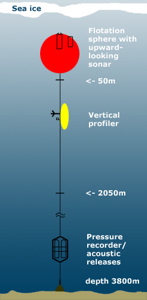 The parts of a mooring. Courtesy of WHOI.
The parts of a mooring. Courtesy of WHOI.
Uh huh, you say. So what? Well- you know that arcade game where you putyour money in to try to pick up your prize out of a jumbled mess ofobjects in a glass box using a joy stick and a claw? Now image that the glass box is the Arctic ocean and your prize is a 3800 meter-longmooring. There may be significant ice in the way.
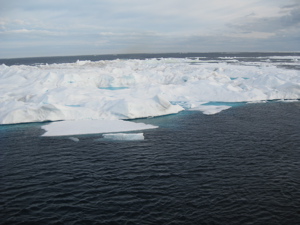 Rick determined that the mooring was under this ice floe. The ship gave the floe a nudge to start it moving, and inertia and wind continued to move it out of the way.
Rick determined that the mooring was under this ice floe. The ship gave the floe a nudge to start it moving, and inertia and wind continued to move it out of the way.
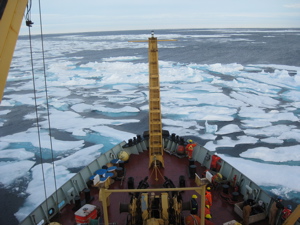 Before recovery, the ship breaks up surrounding ice so that if pieces happen to float into the mooring operations, they are small enough to not be in the way or can be pushed aside by the bubbler.
Before recovery, the ship breaks up surrounding ice so that if pieces happen to float into the mooring operations, they are small enough to not be in the way or can be pushed aside by the bubbler.
To win the game, you have to locate it, steam an icebreaker over thelocation, breaking and moving any ice that may be in the way, then send anacoustic signal to a hook on the bottom telling it to let go of the anchor and send your prize to the top.
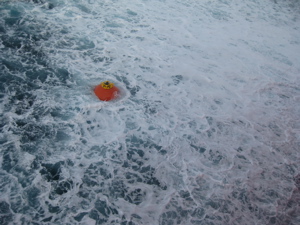 About 20 seconds after Rick sent the signal to the release to let go, the top float popped up *right next to* the ship! Now that is right on! The foaming action comes from the ship's bubbler system, which gives the Captain precise control over moving the bow and can move away any ice that drifts nearby.
About 20 seconds after Rick sent the signal to the release to let go, the top float popped up *right next to* the ship! Now that is right on! The foaming action comes from the ship's bubbler system, which gives the Captain precise control over moving the bow and can move away any ice that drifts nearby.
Once the top float is at the ocean surface , it is hooked and brought onboard. This is not quite as easy as it sounds..... Today is relatively calm with no ice but some wind, so hooking top flotation sphere (or topfloat) takes about half an hour of dangling and ship maneuvering. Your prize is 30 feet below the ship deck.
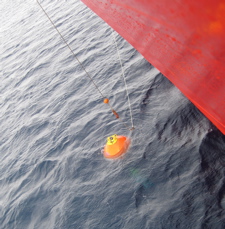 To bring the top float on board, it has to be caught first! A hook is lowered with a control rope (white, to the right of the line) and not unlike that arcade game where you maneuver a joy stick to pick up a prize, the top float is hooked.
To bring the top float on board, it has to be caught first! A hook is lowered with a control rope (white, to the right of the line) and not unlike that arcade game where you maneuver a joy stick to pick up a prize, the top float is hooked.
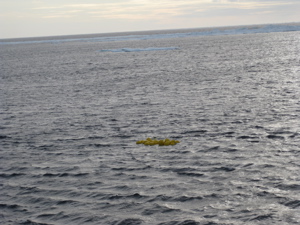 About 20 minutes after the mooring is released, the glass balls are spotted off the starboard side. These will be the last part of the system to be brought on board.
About 20 minutes after the mooring is released, the glass balls are spotted off the starboard side. These will be the last part of the system to be brought on board.
Once the orange top float is brought on board, the rest of the mooring can be recovered.
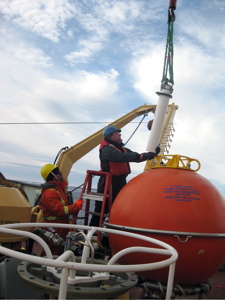 Once the mooring is on board, Rick removes the upward-looking sonar, which collects data on ice thickness.
Once the mooring is on board, Rick removes the upward-looking sonar, which collects data on ice thickness.
This is a long process, taking about 6 hours. 3800 meters of wire must be reeled on board.
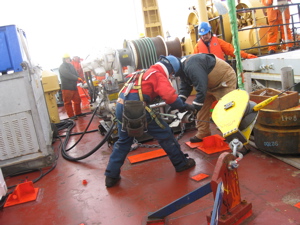 Will and Jim put a diaper on the line so the connection will go through the spooler smoothly. Do you know the mechanical advantage of that pulley?
Will and Jim put a diaper on the line so the connection will go through the spooler smoothly. Do you know the mechanical advantage of that pulley?
The MMP is recovered, and finally it is time to bring in the glassflotation spheres (glass balls), all 58 of them. Each ball provides 50pounds of buoyancy. This 2900 pounds of buoyancy plus an additional 2500pounds provided by the top float give the mooring a total off 5400 poundsof buoyancy.
Question: WHY is so much buoyancy needed? (Hint: the anchor on the bottom weighs 4000 pounds).
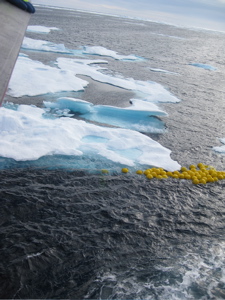 The glass balls are the last thing to be brought aboard.
The glass balls are the last thing to be brought aboard.
All in a day's work!
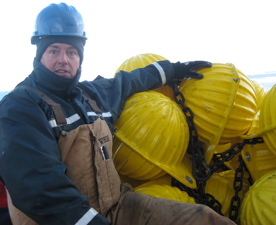 Another successful WHOI mooring recovery!
Another successful WHOI mooring recovery!
Stay tuned...........tomorrow they will put the whole thing back in foranother year of data collecting under the ice.
So long, for now, from the Louis.
Check out the video!
http://

